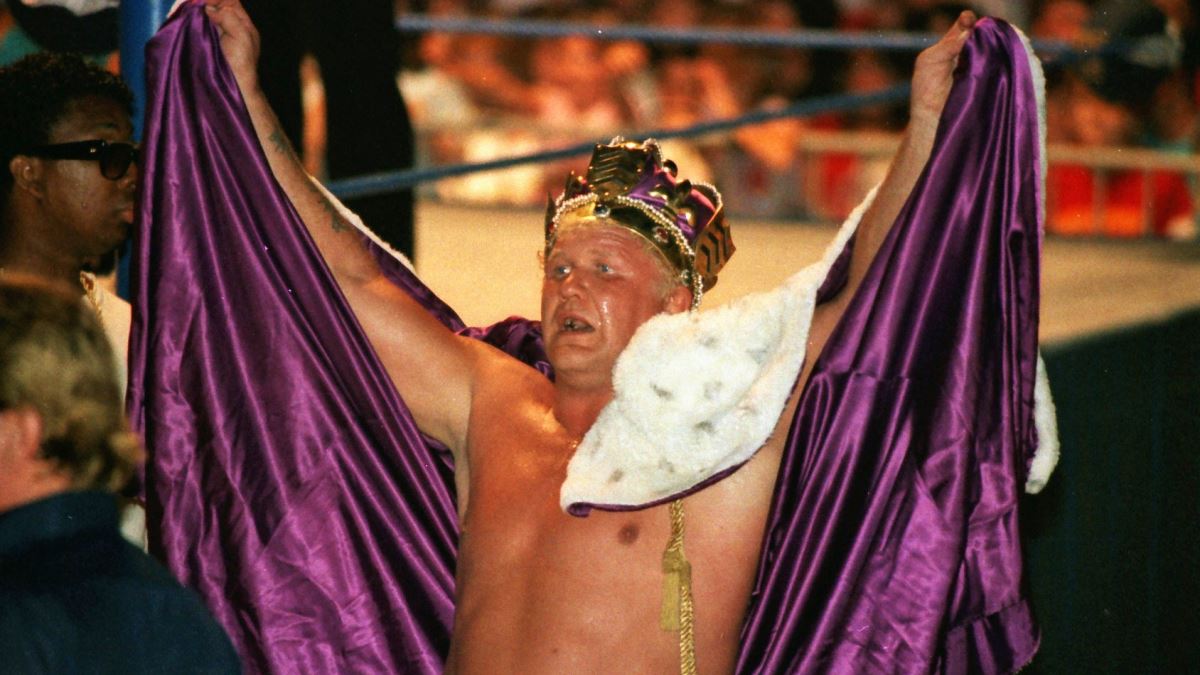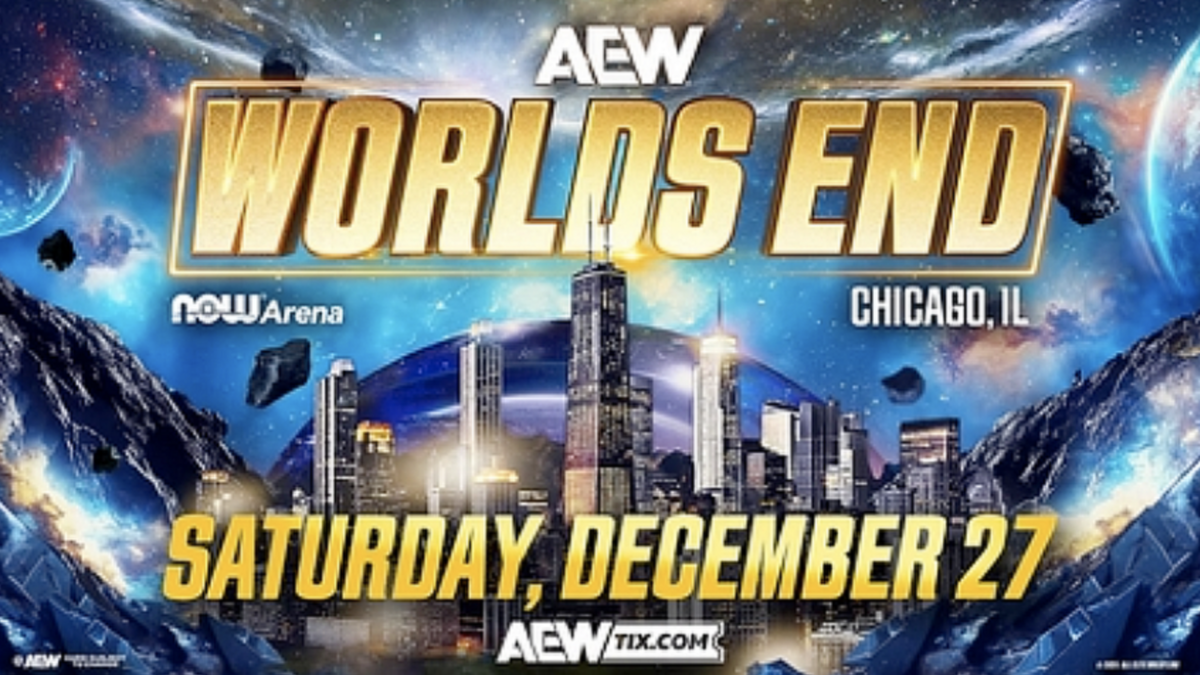The royal wedding. Sick of it yet? Of course, pro wrestling has had its own share of weddings, just never a royal one.
When Dusty Rhodes started one of his famous promos with the line, “I have wined and dined with kings and queens …” he wasn’t lying. There have indeed been kings, queens, princes, princesses, lords, duchesses and even sultans. Most were memorable, but some are just better left forgotten. Take King Hacksaw. Please.

And then there are those who will never be forgotten, like King Curtis Iaukea, who rose to fame in the early 1970s. He was a huge star in Australia, and went on to hold the WWWF Tag Team titles with a fellow member of the upper class, Baron Mikel Scicluna, who was apparently of royal lineage in his native Malta. Younger fans will remember King Curtis as the spokesman for the Dungeon of Doom in ’95. He passed away late last year at the age of 73, and is surely now smiling down on us from the kingdom of Heaven.
Another popular baron in the 1970s was Baron von Raschke. He was known for his finishing move called the “brain claw,” which was often censored on television, because it drew blood whenever it was applied. While he was levels below a king in terms of nobility, Von Raschke certainly had his own collection of gold. He became the first recognized NWA Television Champion in 1978, and would later team with The Crusher to win the AWA World Tag Team titles.
Von Rashcke had a bit of success in the tag team ranks of the AWA. But the crown jewel of the company was the World Championship, which was more suited for a king, like Jerry Lawler.
Lawler first won the AWA Southern Heavyweight Championship in 1974, when he officially declared himself “the King of Wrestling” — having, admittedly, stolen the title and the crown idea from the late Bobby Shane. He defeated his long-time mentor and trainer Jackie Fargo for that title and is to this day, the longest reigning king in the history of the business. (And we’re ignoring all the “King Kong” folks, since they were named after an ape, not a sovereign.)

And the business goes back a long way. In wrestling’s early days of showmanship, the 1930s and 1940s, it was easy to get heat walking to the ring with your nose in the air, looking down on the peons in the crowd. Lord Patrick Lansdowne Finnegan (Wilbur Finran of Ohio) was the first to really hit it big pulling the royal wig over others’ eyes. And, despite how many times others like Michael Hayes or Hulk Hogan may claim, it was Lansdowne who came to the ring to the regal sounds of Pomp and Circumstance.
The TV era brought out the likes of Lord James Blears, Lord Carlton, Lord Athol Layton, Duke Noble, Duke Myers, Princess Little Cloud, Princess Victoria, Princess Jasmine, “The Duke of Dorchester” Pete Doherty, Duke Keomuka, and the biggest of them all, Lord Littlebrook.

But in the ’80s, the WWE (then WWF) took the regal standard to a new level with a tradition called the King of the Ring tournament. It was a round-robin, single elimination tournament, where the winner would actually be declared as king. The first tournament was held in 1985, and was won by the Magnificent Don Muraco. However, the robe, crown and scepter were never embraced until the second tournament was held one year later. That year, it was won by former seven-time NWA World Heavyweight Champion Harley Race, who was already a huge star, and didn’t really need to solidify that with a crown. But this was a fresh run for him in the WWF, a way to acknowledge past accomplishments, and he even took WWF Women’s Champion The Fabulous Moolah as his queen.
By the end of the decade, there was a new king, King Haku. He was known as King Tonga years earlier, but only in name — though he could have been a real king in Tonga for all us marks knew. At this time, the WWF was heavy on characters, and Haku was able to take this ball, and run with it for a while. Haku wasn’t much of a talker, but fortunately he was paired with one of the best talkers in the business as his manager. Bobby Heenan really put this gimmick over, just like he did when Harley Race was king. But of course, all good things must come to an end.
Hacksaw Jim Duggan defeated Haku in 1989 to win the crown. He didn’t really embrace the gimmick as much as he could have, but fortunately, he had a short run, and could eventually go back to doing his thing.
Randy Savage was one of the most popular wrestlers in the business. And his transition from the Macho Man to the Macho King, didn’t hurt his popularity one bit. If anything, it made him more popular. The addition of Sherri Martel as his queen was a nice touch, as the two of them had great chemistry. Savage ran with the gimmick for about two years, before being forced into retirement, after losing a match to the Ultimate Warrior, who may have been the king of parts unknown.
The “King” gimmick would not be seen again in the WWF until 1993, when the King of the Ring tournament was resurrected. Bret Hart had just lost the World Championship to Yokozuna at that year’s Wrestlemania (hosted by another famous ruler, Julius Caesar), but bounced right back to become the King of the Ring. Jerry Lawler, who had just signed with the WWF, did not take this news well. He suggested that in addition to the crown and robe, Bret should also wear the throne. This started a feud to determine the rightful king of the WWF. Lawler eventually won his royal title back due to all kinds of underhandedness and technicalities. And just like his book suggests “It’s good to be King.”

Lawler may have been jealous of Bret Hart, but not quite as jealous as Bret’s younger brother Owen. Owen made it his goal to outdo Bret in every way imaginable. And the first step to accomplishing this was to win the King of the Ring tournament. It may have been controversial, but Owen did win the tournament. And he not only declared himself as the King of the Ring, but he stated from that day forward that he was to be referred to as “The King of Harts.”
In the meantime, WCW had its own royal party. When William Regal first started wrestling in the States, he was wrestling under the moniker Lord Steven Regal. Memorably, he tried to culture southern boy Bobby “Earl” of Eaton.
At the time, there was no tournament that could match the popularity of the King of the Ring. Over the next decade or so, the King of the Ring tournament had launched the careers of future main eventers such as “Stone Cold” Steve Austin, Triple H, Kurt Angle, Edge, Brock Lesnar, and Booker T. But of course, not every tournament winner was a success. In fact, winning the tournament had a bit of an adverse effect on Mabel, Billy Gunn and William Regal; all the king’s horses and all the king’s men could never put their careers together again.
Sadly the most recent King of the Ring tournament didn’t exactly turn out as well as many had hoped. While Sheamus is currently the United States Champion, about a year ago, he was the WWE Champion. So some might say that winning the King of the Ring was actually a step backwards for him.
Outside of being World Champion, there was no honour higher than being a King. Some actually took the gimmick to an international level. Though he is best known as Rikishi, Solofa Fatu was once royalty as well, when he competed as the Sultan (a heavy-duty throne that must have been). Sultan was originally an Arabic term, meaning “authority” or “power,” but it was later accepted as a royal title. Ring of Honor’s Prince Nana is currently adding some international flavour to his gimmick as well. He claims to be an heir to the throne of Ashanti in Ghana, West Africa. And his costume says it all.
And then there are those who have never been associated with any royal family, but merely use royal titles as nicknames. For instance, everyone knows that Chris Jericho is the King of the World. And if you don’t, he’ll be the first in line to tell you. Long before the book of DILLIGAF was published, Shannon Moore was calling himself the Prince of Punk. It’s also no secret that Stephanie McMahon has always been known as the Billion-dollar Princess. But when she was drenched with milk at the hands of Kurt Angle, Jim Ross came up with a great line, saying “The Billion-Dollar Princess has just become the Dairy Queen.” Even though Madison Rayne wears a tiara on her head, her theme music suggests that she’d rather be a queen than a princess. When Stacy Keibler acted as the valet for The Dudley Boys, Paul Heyman started referring to her as the “Duchess of Dudleyville.” And of course, you’re likely to get crowned with a guitar if you don’t refer to Jeff Jarrett as the King of the Mountain.

Even today, there is a group in Ring of Honor, who call themselves the Kings of Wrestling. No it isn’t Jeff Jarrett, Scott Hall and Kevin Nash. It is the combination of Claudio Castagnoli, Chris Hero and Shane Hagadorn. And while every great king has his queen, Sara Del Rey is nobody’s underling. And she proves it time and time again in the squared circle. Del Rey is the Queen of Wrestling and has undoubtedly earned that title — though it’s also the title of a superb biography of Mildred Burke.
So as we get set for the royal wedding on April 29, let us wrestling fans take a moment to reflect on our favourite “royals” that have ruled the professional wrestling kingdom for so long.



